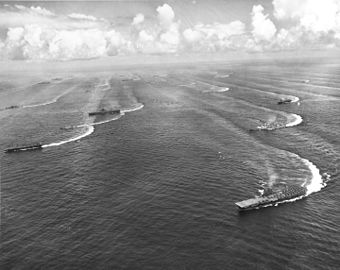Japan_campaign
Japan campaign
Campaign in Japan during the Second World War
The Japan campaign was a series of battles and engagements in and around the Japanese home islands, between Allied forces and the forces of Imperial Japan during the last stages of the Pacific campaign of World War II. The Japan campaign lasted from around June 1944 to August 1945.
| Japan campaign | |||||||
|---|---|---|---|---|---|---|---|
| Part of Pacific War | |||||||
 Task Force 38, of the U.S. Third Fleet maneuvering off the coast of Japan, 17 August 1945, two days after Japan agreed to surrender. | |||||||
| |||||||
| Belligerents | |||||||
|
|
| ||||||
| Commanders and leaders | |||||||
|
|
| ||||||
| Casualties and losses | |||||||
| Comparatively light |
193,300 soldiers dead (all causes)[3] Surrendered and captured following blockade and bombings: 4,335,000 soldiers[4] 9,435 artillery pieces 5,286 tanks 731 other AFVs 12,682 aircraft (mostly kamikazes)[5] | ||||||
Periodic air raids on Japan were the first attacks undertaken by Allied forces. In late 1944, these raids were followed by a major strategic bombing of cities, factories, and other war infrastructure throughout Japan, most notably:
- Operation Meetinghouse raid on Tokyo (9-10 March 1945): 100,000 Japanese were killed, mostly civilians, including in the conflagration that followed the firebombing.
- Bombing of Kure (24-28 July 1945): Most of the surviving large Japanese warships were lost, leaving the Nagato as the only remaining capital ship in Japan's inventory.
- Atomic bombing of Hiroshima (6 August 1945): Of approximately 90,000–140,000 deaths, 20,000 were Japanese combatants and 20,000 were Korean slave laborers.
- Atomic bombing of Nagasaki (9 August 1945): Of approximately 39,000–80,000 deaths, 27,778 were Japanese munitions workers, 2,000 were Korean slave laborers, and 150 were Japanese combatants.
The air raids resulted in heavy damage to Japanese infrastructure and the deaths of 241,000–900,000 Japanese citizens (mostly civilians), as well as the loss thousands of aircraft and flak guns. The Allies, in turn, only lost a few hundred aircraft (mostly bombers) to Japanese anti-air defenses and fighters.
In early 1945, there were two major island battles:
- The Battle of Iwo Jima (16 February to 26 March): Of approximately 21,000 Japanese defenders, only 216 survived.
- The Battle of Okinawa (1 April to 21 June): Of approximately 100,000 Japanese defenders, only 24,455 survived.
There were also two naval battles:
- Operation Ten-Go (7 April): All but four Japanese vessels committed were lost.
- The Battle of Tokyo Bay (22 and 23 July 1945): Most of the Japanese vessels committed were heavily damaged or lost.
Allied warships also bombarded several Japanese cities during July and August 1945.
The battles of Iwo Jima and Okinawa foretold what was to be expected when the Japanese Home Islands were attacked. Iwo Jima and Okinawa were lost only after extremely fierce resistance was overcome. In both cases, the Japanese refused to surrender and there were few survivors. While Japanese losses were extremely high, Allied forces paid dearly to take both islands.
Naval operations included a suicidal Japanese counteroffensive on 7 April 1945 (Operation Ten-Go), to relieve Okinawa and an Allied campaign to place air and submarine-delivered mines in Japanese shipping lanes. This was illustrated by the naval surface interdiction of Tokyo Bay in July 1945.
In late 1945, the Soviet Union launched a series of successful invasions of northern Japanese territories, in preparation for the possible invasion of Hokkaido:
- Invasion of South Sakhalin (11—25 August)
- Maoka Landing (19—22 August)
- Invasion of the Kuril Islands (18 August to 1 September)
- Battle of Shumshu (18—23 August)
World War II ended with the surrender of Japan after the atomic bombings of Hiroshima and Nagasaki. Before those two attacks, Japan was unwilling to surrender. The firebombing of Japanese cities resulted in 350,000 civilian deaths but did not move the government towards surrender. The Japanese government was clearly prepared to fight an Allied invasion of the home islands as fiercely as they had defended Iwo Jima and fought on the Japanese home island of Okinawa.
The Japan campaign was intended to provide staging areas and preparation for a possible Allied invasion of Japan and to support Allied air and naval campaigns against the Japanese mainland. Japan still had a homeland army of about two million soldiers and sufficient resources to cripple an Allied invasion. Consequently, had that invasion been necessary, it most likely would have resulted in a much higher death toll for both sides.[citation needed]
- Surrender of Japan
- Japanese Instrument of Surrender
- Japanese war crimes
- Occupation of Japan
- United States strategic bombing of Japan
- Soviet invasion of Manchuria — Launched by the Soviet Union after the first atomic bombing.
- Victory over Japan Day
- The date of Double Strike, which is the beginning of Mainland Air Strike.
- The Archipelago Landing Operation is over.
- "Figures were compiled by the Relief Bureau of the Ministry of Health and Welfare in March 1964". Australia-Japan Research Project. Archived from the original on 11 March 2016. Retrieved 10 March 2016.. Combined death tolls of "Japan proper" (103,900) and Okinawa (89,400).
- Ministry of Health and Welfare, 1964. Archived 2016-01-05 at the Wayback Machine
- Final report: progress of demobilization of the Japanese Armed Forces, 30 December 1946 Part 2, Supreme Command of the Allied Powers, p. 49, archived from the original on 4 March 2016, retrieved 26 December 2015. Artillery is defined as being at least over 80 mm in caliber.
- Drea, Edward J. (1998). In the Service of the Emperor: Essays on the Imperial Japanese Army. Nebraska: University of Nebraska Press. ISBN 0-8032-1708-0.
 Media related to Japan campaign at Wikimedia Commons
Media related to Japan campaign at Wikimedia Commons